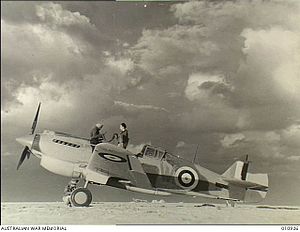Curtiss P-40 variants
| P-40 Warhawk Tomahawk / Kittyhawk |
|
|---|---|
 |
|
| Tomahawk of No. 3 Squadron RAAF in North Africa, 23 December 1941. | |
| Role | Fighter aircraft |
| National origin | United States |
| Manufacturer | Curtiss-Wright |
| Designer | Don R. Berlin |
| First flight | 14 October 1938 |
| Retired | 1958: Brazilian Air Force |
| Primary users |
United States Army Air Forces Royal Air Force Royal Australian Air Force Royal Canadian Air Force |
| Produced | 1939–1944 Buffalo, New York |
| Number built | 13,738 |
| Unit cost |
US$44,892 in 1944
|
| Developed from | Curtiss P-36 Hawk |
| Variants | Curtiss XP-46 |
The P-40 went through four significant transformations, comprising 10 official variants, in its international military service.
Twin nose guns, smaller engine cowling, "long" nose
1941–43
This was a very important type for the allies in the early part of the war. Many were destroyed on the ground at Pearl Harbor and in the Philippines in December 1941; it did well with the AVG in China and Burma, and was an effective fighter available to the RAF in the early months of the Desert War. It was also a small but important part of the Soviet arsenal in 1942, being one of the few types available to them which could take on the Bf 109. The earliest version (P-40) had only four guns and lacked armor plate or self-sealing tanks, but the British pressed these into service into North Africa anyway as Tomahawk Is. The P-40B (Tomahawk IIa) had armor behind the pilot, an armored windscreen and partially protected fuel tanks, the P-40C (Tomahawk IIb) had a fully protected fuel system, provisions for a drop tank, and became heavier, reducing speed to under 350 mph. The Soviets reportedly stripped the wing guns from some of their Tomahawks to improve performance. Used extensively by the RAF's Army Cooperation Command from February 1941 in developing high speed, low level, tactical reconnaissance for the British Army. Replaced by the Mustang I in mid 1942.
There were a variety of differences between the British Commonwealth and US variants, (starting with the guns, .303 instead of .30 caliber) so that there is not actually an exact correlation between specific US variants (P-40B etc.) and British Commonwealth export versions (i.e. 'Tomahawk')
Deeper engine cowling, ('definitive' P-40 "Look") four/six wing guns, "short" nose
1941–43
This was the first version armed with six .50 caliber machine guns. More powerful than the P-40B/C in terms of armor, armament and performance, this was the type which fought as a fighter during the most crucial period in both the Pacific and North African campaigns. The P-40E played a major role in the defense of Philippines, Java (NEI), Australia and New Guinea in 1942, and with the Desert Air Force (DAF) in intense fighting against the Luftwaffe and Regia Aeronautica also in 1942. The P-40E was also an important type for the Soviets.
In the Desert War the arrival of the Kittyhawk led to the early retirement of the Bf 109E and its replacement by the faster and more maneuverable Bf 109F. The top scoring DAF squadrons, including No. 3 Squadron RAAF and No. 112 Squadron RAF, transferred from the Tomahawk to the Kittyhawk, scoring many kills against Luftwaffe and Regia Aeronautica types, helping the DAF to hold on through this tough period.
...
Wikipedia
